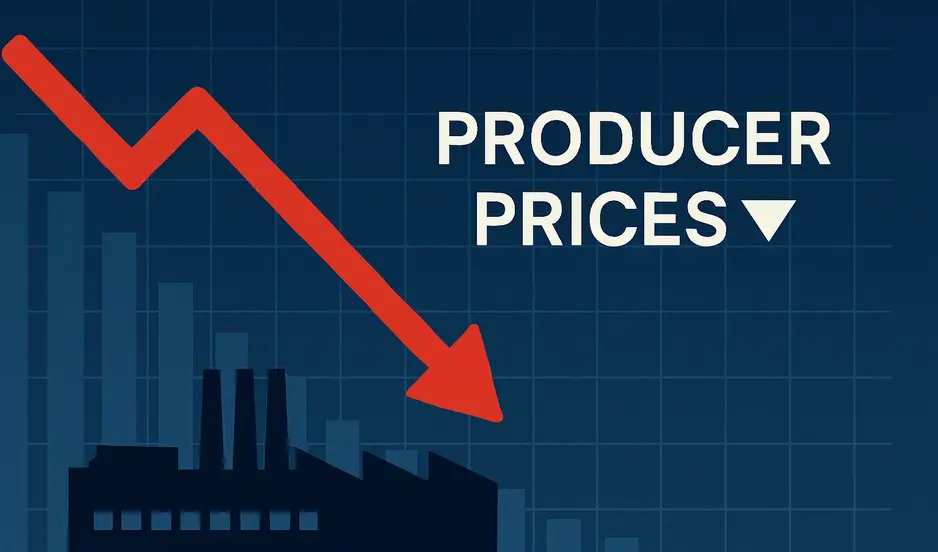In August 2025, U.S. producer prices unexpectedly fell by 0.1%, surprising economists who had been expecting a rise. According to the Bureau of Labor Statistics, costs for services dropped 0.2%, while goods prices crept up just 0.1%. On an annual basis, the Producer Price Index (PPI) rose 2.6%, down from 3.1% in July.
This dip suggests inflation pressures are calming somewhat, especially in services where the inflation spike had been sharper. Amid larger concerns about tariffs, labor market softening, and economic growth, this data adds more weight to expectations that the Federal Reserve may cut interest rates at their next meeting.
Why the Drop in Producer Prices Matters
Easing Inflation at Wholesale Level
Wholesale costs are often an early signal of what consumers might eventually face. When producer prices slow or fall, it can indicate that businesses are absorbing costs or facing lower demand rather than passing inflation downstream.
Services Inflation Cooling Faster
The 0.2% decline in services cost is particularly noteworthy. Retailers and wholesalers, for instance, saw smaller margins, and that put downward pressure on prices in services. This happens when competition squeezes profit margins, and companies can’t—or won’t—pass along cost increases.
Implications for the Fed
With inflation indicators softening and labor market data showing signs of weakening, the Fed has more reason to consider reducing borrowing costs. A rate cut has become more likely for the upcoming meeting. Market watchers are now pricing in a near-certain quarter-point cut.
Producer Prices Slip in August
With services costs easing and inflation showing signs of relief, now is the right moment to strengthen your hiring strategy. Get ahead of the competition by posting your jobs on WhatJobs — free for 30 days.
Post a Job Free for 30 Days →Where Risks & Uncertainties Remain
Even with the drop, some caution is warranted. Goods prices still rose slightly, signaling that cost pressures haven’t disappeared. Tariffs and import taxes may yet exert influence on wholesale and consumer inflation. And falling prices in services may lag behind changes in input costs, meaning the full effect may take time to show up at the consumer level.
Also, if demand falls sharply, businesses may cut back on hiring or investment, risking a slowdown in economic growth. Combined with already weak job growth in recent reports, the risk of recession remains nontrivial.
What This Means for People in the Workforce
Workers often feel inflation in their everyday expenses—housing, food, utilities—more than in wholesale price charts. While lower producer prices don’t immediately translate to lower consumer inflation, they suggest some easing in cost pressures.
For employees in industries like retail, wholesale, or service sectors, the relief could mean smaller price hikes or less urgency from employers to raise compensation aggressively. But in sectors tied to goods production, supply chains, or import-dependent industries, cost pressures may still be felt.
FAQs
Q1: What is a Producer Price Index (PPI) and why does this slip matter?
The Producer Price Index measures the average changes over time in the selling prices received by domestic producers for their output. A slip, like the 0.1% drop in August, can signal easing inflation pressures at the wholesale level, which may eventually affect consumer prices.
Q2: Why did service costs fall more than goods in August?
Service sectors like wholesale and retail saw reduced profit margins and weaker demand, which caused businesses to lower or hold off on raising prices. Goods prices edged up, so the pressure remains uneven.
Q3: Will this data push the Federal Reserve to cut rates?
It strengthens the case. The unexpected drop in producer prices, along with weak job growth and revised downward payroll estimates, increases pressure on the Fed to consider easing interest rates.
Q4: How might this affect inflation experienced by everyday people?
If wholesale price pressures ease, businesses may have more room not to aggressively raise prices on consumers. That could slow the rate of inflation for goods and services in coming months—but there may be lag.
A Small Retailer’s Pricing Dilemma
Sara owns a small boutique in Ohio that sells both goods and service-based items (like tailoring or repair). In July, she was forced to raise service prices because the companies she contracts with raised their costs. In August, she noticed her suppliers holding prices steady, and for her services, she actually delayed a planned price increase.
This gave her customers a brief sense of relief. But Sara is cautious: she expects some of her vendors to pass along higher costs in the fall. For her business planning, the August PPI slip helped her delay increases, but not forever.




